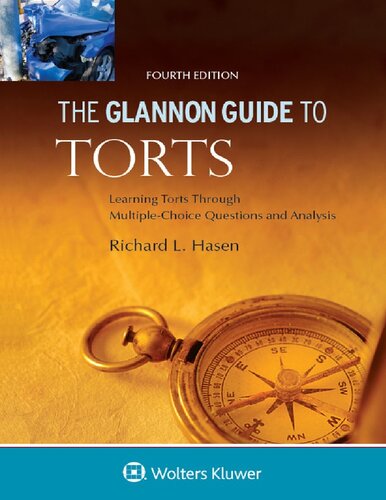

Most ebook files are in PDF format, so you can easily read them using various software such as Foxit Reader or directly on the Google Chrome browser.
Some ebook files are released by publishers in other formats such as .awz, .mobi, .epub, .fb2, etc. You may need to install specific software to read these formats on mobile/PC, such as Calibre.
Please read the tutorial at this link. https://ebooknice.com/page/post?id=faq
We offer FREE conversion to the popular formats you request; however, this may take some time. Therefore, right after payment, please email us, and we will try to provide the service as quickly as possible.
For some exceptional file formats or broken links (if any), please refrain from opening any disputes. Instead, email us first, and we will try to assist within a maximum of 6 hours.
EbookNice Team

Status:
Available5.0
15 reviews
ISBN 10: 1543807747
ISBN 13: 978-1543807745
Author: Richard L. Hasen
A concise, clear, effective review of Tort law topics organized around the theme of multiple-choice questions. The basic format follows the same structure established by the first title in the series, Joseph Glannon’s The Glannon Guide to Civil Procedure. The book includes brief explanatory text about the topic under discussion, followed by one or two multiple-choice questions. After each question, the author explains how the correct choice was chosen. Thus the student reviews course content and also learns how to analyze exam questions.
Features:
Integrates multiple-choice questions into a full-fledged review of the first-year Torts course
Lead-up discussion of law in the text prepares students to learn effectively from subsequent questions
Clear explanations of correct and incorrect answers help to clarify nuances in the law
Multiple-choice questions are sophisticated but fair, neither too difficult nor unrealistically straightforward
Equally useful to all students, regardless of whether they will be tested by multiple-choice questions on their exams
Embodies a far more user-friendly and interactive approach than other exam preparation aids
A more challenging final question in each chapter (the “Closer ” ) illustrates a more sophisticated problem in the area under discussion
“Closing Closer” questions in the last chapter provide practice and helpful review of concepts in earlier chapters, meant to test knowledge across the range of Torts issues
Valuable exam-taking pointers interspersed within the substantive text
New to the Second Edition:
New material on “cybertrespass” and other Internet-related intentional tort
Updated material on Supreme Court cases governing the preemption of state tort law claims
Incorporation of material from the newly approved portions of the Restatement Third of Torts, Liability for Physical and Emotional Harm, including detailed treatment of the Third Restatement’s new approach to Intentional Infliction of Emotional Distress
Updated material on the Supreme Court’s treatment of constitutional questions concerning the award of punitive damages
Additional Closing Closers
1. A Very Short Introduction
2. Diversity Jurisdiction: The Basic Rules
3. Federal Claims and Federal Cases
4. Removal Jurisdiction: The Defendant Chooses the Forum
5. Personal Jurisdiction: Myth and Minimum Contact
6. More Personal Jurisdiction: General In Personam Jurisdiction and In Rem Jurisdiction
7. More than an Afterthought: Long-arm Statutes as a Limit on Personal Jurisdiction
8. Home and Away: Litigating Objections to the Court's Jurisdiction
9. Due Process and Common Sense: Notice and Service of Process
10. Venue and Transfer: More Limits on the Place of Suit
11. State Law in Federal Courts: Basics of the Erie Doctrine
12. Two Ways to Run a Railroad: Substance and Procedure After York, Byrd, and Hanna
13. The Scope of the Action: Joinder of Claims and Parties Under the Federal Rules
14. Of Hooks and Nuclei: Supplemental Jurisdiction over State Law Claims
15. Sufficient Allegations: Pleading Under the Federal Rules
16. Change over Time: Amending the Pleadings Under Rule 15
17. Never Forget Rule 11: Representations to the Court
18. Technicalities, Technicalities: Pre-answer Motions Under the Federal Rules
19. Probing to the Limits: The Scope of Discovery Under the Federal Rules
20. The Basic Tools of Discovery in Federal Court
21. Dispositive Motions: Dismissal for Failure to State a Claim and Summary Judgment
22. Judgment as a Matter of Law in the Federal Courts
23. Second Time Around: The Grounds and Procedure for Motions for New Trial
24. The Quest for Finality: Claim Preclusion Under the Second Restatement of Judgments
25. Collateral Estoppel, Issue Preclusion, Whatever
26. Closing Closers: Some Practice Questions that Cross Jurisdictional Lines
27. Closing Openers: Some Looney Limericks
Index
the glannon guide to torts
the glannon guide
glannon torts
glannon guide to criminal law
glannon guide to constitutional law
Tags: Richard Hasen, The Glannon Guide, Learning Torts, Questions and Analysis